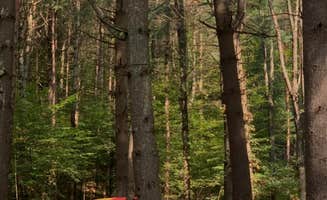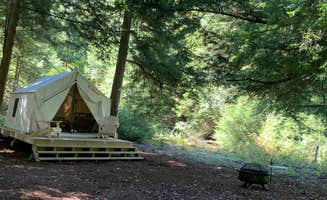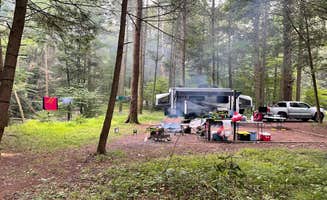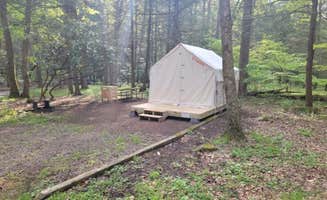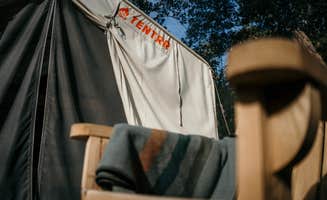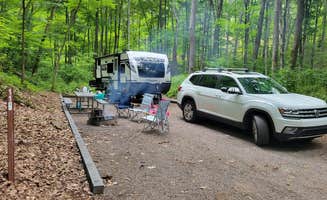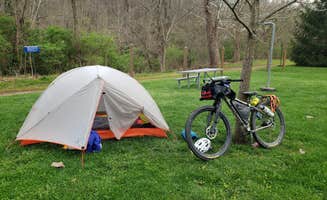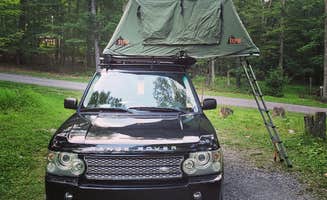Camping near Grantsville, Maryland features a cooler climate with temperatures averaging 10-15 degrees lower than surrounding regions due to its elevation in the Appalachian Mountains. The area sits within Garrett County, Maryland's westernmost county, which contains numerous streams and waterways flowing through heavily forested terrain. Primitive camping options typically open earlier in spring and stay open later into fall than developed campgrounds, with most accepting reservations April through December.
What to do
Paddle the reservoir waters: At Big Run State Park Campground, campers can easily access Savage River Reservoir for kayaking. "The camp sites next to the reservoir have no privacy but offer extremely easy access for canoes/kayaks," notes a visitor, adding that "It is close to the Savage River reservoir, which is great for kayaking."
Tackle mountain biking trails: Western Maryland offers excellent riding opportunities within a short drive from campgrounds. "The whole campground sits in kind of a valley along a creek running into the reservoir. It's kind of spread out but seemed nice," writes a camper at Tub Run, who visited specifically "for a weekend to go rafting."
Fish for trout in mountain streams: Campsites along creeks provide direct access to fishing. "Stream was incredible and lively with trout and crayfish," reports a camper at Big Run State Park. Look for spots where streams widen into small pools for the best fishing access.
Explore hiking networks: The region connects multiple trail systems across state parks. "Plenty of hiking in the park and in the adjacent parks like New Germany state park," writes a Savage River camper. Many trails feature elevation changes of 500-800 feet, offering moderately challenging hiking with scenic rewards.
What campers like
Seclusion between sites: Savage River State Forest receives praise for its widely spaced campsites. "The sites are very spread out, and not very consistent in size/quality. We were able to nab site 112 and it was fantastic: lots of space, and privacy too," shares one camper. Another adds, "There are no amenities here besides a picnic table and a fire ring, but the sites are so spread out that it's basically like dispersed camping but on a paved road."
Old-growth forest settings: The natural landscape creates immersive environments. At New Germany State Park Campground, a visitor describes it as "a small park nestled in a little pristine valley that feels like you are in another world! You are surrounded by old growth hemlock, miles of trails, and a good lake."
Waterfront camping options: Sites near streams are particularly coveted. "Beautiful campsite and loved the sound of the river as white noise!" says a Big Run camper. Another visitor to the same park notes, "Used lot 73 for a 26ft hybrid camper. Fit perfectly! It was flat, large, clean and right by the creek. The kids loved playing in the water."
Well-marked trail systems: Navigational aids make exploration accessible. "Trails are very nicely kept and clear with maps at every intersection so getting lost is very unlikely," describes a camper at Swallow Falls State Park. This level of trail maintenance is consistent throughout the region's parks.
What you should know
Limited cell service: Most campgrounds in the area have minimal connectivity. "Personally I think the seclusion is well worth the price, but it's worth mentioning that to get potable water we had to drive ~20 minutes. Same deal as far as the for-better-or-worse, but we had no cell service at all for most of the area," reports a Savage River camper.
Temperature variations: The mountain climate brings significant cooling. "I went camping the last week of August and it was beautiful. If you're from the area you know how hot it can be at this time of year but it's at least 10 degrees cooler out here," shares a Savage River visitor.
Insects can be prevalent: Bug protection is essential during warm months. A visitor to Rocky Gap State Park Campground notes, "A lot of gnats and other bugs but no mosquitoes to speak of," while another camper at a different park mentions, "Be prepared for mosquitoes and gnats."
Water access varies by location: Not all campgrounds provide drinking water on site. "Water and dump station is 10 minutes up the road at New Germany State Park," explains a Big Run camper. Carry extra water or know where to refill before arrival.
Tips for camping with families
Choose lake-adjacent campgrounds: Deep Creek Lake State Park Campground offers family-friendly water activities. "The lake is absolutely beautiful and perfect for all types of water sports. It's great for all ages as well, with things to do to keep everybody entertained," shares a visitor. The park maintains a swimming beach with lifeguards during summer months.
Look for level tent sites: Some campgrounds offer better setup conditions than others. "Our tent sites were very nice sitting on raised mounds so you would stay fairly dry if it rained," notes a camper at Yough Lake Campground.
Visit during firefly season: Early summer brings natural light shows. A Savage River camper reports, "We saw no wildlife until we left the site in the morning and saw some deer on the road. Though we did have a spectacular firefly display at night."
Consider cabins during shoulder seasons: When temperatures drop, furnished shelters provide comfort. "The park is very popular amongst cross-country skiers in the winter, especially since they have full-service cabins and a warming hut by the lake," mentions a New Germany visitor.
Tips from RVers
Select campgrounds with adequate hookups: Swallow Falls State Park Campground provides limited but valuable electric sites. "We stayed on site#40 in the Garrett Loop. It is one of only three FHU sites in this loop(the rest are primitive tent sites). The site was level, spacious, beautifully shaded, and convenient to the bath house," shares an RV camper.
Understand site limitations: Many campgrounds have size restrictions. "The roads were very narrow, with a decent incline, so not big-rig friendly," notes a New Germany visitor. Most parks accommodate smaller RVs up to 30 feet, but larger vehicles have fewer options.
Plan for water fill locations: Not all campgrounds offer on-site water hookups. "The water hookups weren't working at the time, but we were able to connect in Cherry Loop and fill our tank," explains a camper at Ohiopyle State Park, highlighting the importance of knowing where to access utilities.
Check site levelness before booking: Many campground sites in the mountains require leveling. "Our site backed up to the creek but surprisingly, there was not a lot of water flowing in the spring," notes a Laurel Hill camper, adding "All sites are gravel; most appeared level, but some did not."




